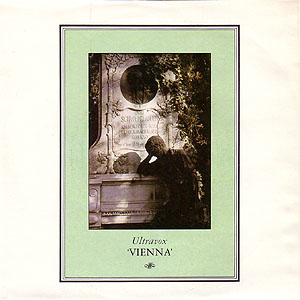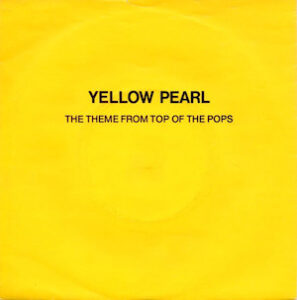A classic year…
1981 proved to be a significant year for music – and was certainly a landmark year for synth-pop. It saw the release of iconic albums that included Depeche Mode’s Speak & Spell, OMD’s Architecture & Morality, Soft Cell’s Non-Stop Erotic Cabaret, The Human League’s Dare and Heaven 17’s Penthouse and Pavement.
At the same time, the charts flourished with a thoroughly eclectic variety of singles which highlighted just how colourful the 1981’s music scene was. In that spirit, this article explores 20 singles which are not necessarily all chart-busting hits, but each served to give 1981 its particular vibe…
![]()
ULTRAVOX – Vienna

The attempt by Ultravox to capture a more elegant sound for a synth-pop song essentially gave the band their most well-known song. “I wanted to use my classical training” commented Billy Currie in a 2017 piece for The Guardian, “I said to the guys I was keen to do something that sounded like the late-19th-century romantics, like Grieg and Elgar.”
“‘Vienna’ was a love song to an imaginary girl” added Midge Ure, “You’ve gone to this beautiful place, met someone and vowed it is going to continue – and, of course, it doesn’t.”
The grandeur and sweep of the composition could have easily been dismissed as pretentious, but the yearning romance of the track captured the public’s attention. Cruelly, ‘Vienna’ was denied the crucial No. 1 spot by Joe Dolce’s novelty hit ‘Shaddap You Face’.
THE TEARDROP EXPLODES – Reward

One of Liverpool’s most notable pop rock outfits, The Teardrop Explodes had previously dabbled in more evocative baroque pop compositions. But ‘Reward’ served up a much more aggressive, bombastic approach with brassy refrains.
The song had been inspired by Alan Gill (Dalek I Love You) who suggested a bassline and melody for the song. Meanwhile, Julian Cope had been inspired to use trumpet on the song by Love’s Forever Changes.
‘Reward’ swiftly became the Teardrop’s signature tune and also managed a respectable No. 6 in the UK charts.
THE PASSIONS – I’m In Love With A German Film Star

The throbbing, dreampop of this particular track made it one of the year’s more stylish entries. Post-punk outfit The Passions had originally formed in 1978 (evolved from earlier group The Derelicts).
The song’s evocative narrative touched the romantic in all of us. Meanwhile, the doleful guitar work weirdly seemed to foreshadow shoegaze.
The Passions’ music adventures were brief (they disbanded in 1983), but glorious if only for this classic song.
NEW ORDER – Ceremony

Following the death of Ian Curtis in 1980, Joy Division reformed as New Order and began their transformation from gothic post-punk act to electropop wonders.
‘Ceremony’ marked New Order’s debut single release and was actually the last Joy Division song to be written. Two versions were actually recorded and released, with Gillian Gilbert providing guitar on the second version. Bernard Sumner had to do his best to work out the lyrics, because Ian Curtis hadn’t transcribed them prior to his passing.
With the song’s tragic backdrop, ‘Ceremony’ can only take on a poignant listening experience. It’s a haunting, gripping composition that has an ethereal, timeless quality – and a fitting epitaph to Joy Division’s legacy.
HEAVEN 17 – (We Don’t Need This) Fascist Groove Thang

Following the split of the original Human League, Martyn Ware and Ian Craig Marsh teamed up with Glenn Gregory to form Heaven 17. Differing from the straight electronic template of the League, Heaven 17 managed to weave in funk elements into much of their material which gave their debut album Penthouse and Pavement a cool, slick sheen which was light years away from the more cold wave approach of their contemporaries.
The 1980s was an era in which political commentary was a firm component of much of the music of the time (particularly during a Thatcher government). Yet even by the standards of the day, ‘(We Don’t Need This) Fascist Groove Thang’ doesn’t shy away from overt statement – which actually led to the single being banned by the BBC at the time.
It still stands as the definitive Heaven 17 anthem in many ways (despite more successful chart releases later) – and its message is even more timely in the current political climate.
MODERN EON – Euthenics

Another ‘lost’ act who originally appeared on the radar of Liverpool’s legendary Inevitable label. Prior to this, they contributed a track to Street to Street: A Liverpool Album, which also boasted pre-OMD outfit The Id. They also signed to Dindisc (OMD’s label at the time) for this reissue of ‘Euthenics’.
As a song, ‘Euthenics’ offers up a strange combination of driving percussion and icy, ethereal vocals. That slightly austere and brooding quality marked it out as a song definitely of its time.
Modern Eon slotted in well with the other post-punk Liverpool scene of the time, although the band didn’t enjoy the longevity and success of their contemporaries. Drummer Cliff Hewitt also later became part of Apollo 440.
PHIL LYNOTT – Yellow Pearl

Anyone tuning into Top Of The Pops in 1981 couldn’t escape the powerful theme music with that screaming intro. But the song had originally been co-written by unlikely musical buddies Phil Lynott and Midge Ure (the tune had been drummed up during a period when Ure was playing keyboards for Thin Lizzy during their 1979 Japan tour).
The composition had been conceived for Lynott’s 1980 solo album Solo in Soho. But it caught the ear of TOTP producer Michael Hurll at the time who suggested something similar as a theme song for the music show. Lynott had apparently suggested they just use ‘Yellow Pearl’ and the song was subsequently remixed to give it its distinctive, dynamic synth-pop sound.
HUMAN LEAGUE – The Sound of the Crowd

1981 was a good year for The Human League, although smash hit ‘Don’t You Want Me’ and iconic album Dare were still a few months off when they released this single.
At this point, the League were a niche electronic outfit, but ‘The Sound of the Crowd’ boasted snappy pop rhythms, smart percussion and some effective synth flourishes. The single was also the first to feature a distinctive marketing tactic, where Human League singles were labelled either ‘Red’ or ‘Blue’. ‘Red’ being designated for dance tracks, while ‘Blue’ was for pop songs.
Consequently, it became their breakthrough single reaching No. 12 in the UK charts.
A FLOCK OF SEAGULLS – (It’s Not Me) Talking

This marked the debut single for synth outfit and mad hair aficionados A Flock Of Seagulls.
Produced by Bill Nelson (and originally released on Nelson’s Cocteau label), the song has a suitably sci-fi theme and a raw vitality to it. Arriving at a time when synth-pop was on the rise certainly helped, but there was always a particular quality to the wistful compositions that A Flock Of Seagulls cooked up that set them apart.
The band’s best successes were still a year off, but ‘(It’s Not Me) Talking’ shows that A Flock Of Seagulls had something worth paying attention to.
DEPECHE MODE – New Life

Depeche Mode had also got off the starting blocks in 1981, although their mega stardom days were still to come.
Their second single release, ‘New Life’ demonstrated that electronic pop didn’t need to be cold and bleak, but actually fun. The synth hooks and tight arrangement granted Basildon’s Finest their first real taste of chart action when ‘New Life’ reached No. 11.
The band also made their Top Of The Pops debut as a result. The aptly named ‘Just Can’t Get Enough’, released later that year, would keep DM’s momentum going.
DURAN DURAN – Girls On Film
 Duran Duran scored their breakthrough hit with ‘Girls On Film’, which was likely enhanced by controversy over the raunchy promo video that accompanied it (subsequently banned by the BBC – usually the sure-fire method to guarantee a hit).
Duran Duran scored their breakthrough hit with ‘Girls On Film’, which was likely enhanced by controversy over the raunchy promo video that accompanied it (subsequently banned by the BBC – usually the sure-fire method to guarantee a hit).
Duran Duran were the act that your sister loved while you turned your nose up and found solace in your OMD and Ultravox albums. But you couldn’t deny their knack for writing a tune.
The song’s sharp percussion, catchy hooks and anthemic vocals could hardly fail, giving it a prestigious No. 5 in the UK charts (it also reached No. 1 in Portugal).
OMD – Souvenir

OMD’s rapid chart success had already been paved through some strong singles (including the international hit ‘Enola Gay’), but 1981 sealed the deal with their stunning Architecture & Morality album (see TEC feature).
‘Souvenir’ was the first single from the album and was the precursor to the band’s obsession with a choral sound. Paul Humphreys and Martin Cooper had experimented with some tape loops of a choir warming up to produce what was initially a very abstract song.
Initially titled ‘Choir Song’, the composition was much slower in its original incarnation, but the choral sounds had a strange, haunting quality that marked this track out as something special. The song certainly caught the imagination of producer Mike Howlett who convinced the band to go into Wessex Studios to record it. The single, which marked the first time that OMD founder-member Paul Humphreys performed lead vocal on one of the band’s singles proved to be their biggest hit of their career up to that point reaching No. 3 in the UK charts.
JAPAN – Quiet Life

Chugging away in the smarter end of the electronic pop field, Japan had initially struggled to make any headway in the UK. That situation changed when they served up the bass grooves of ‘Quiet Life’ taken from their 1979 album of the same name.
Discussing the album, The Quietus suggested “it defined a very European form of detached, sexually-ambiguous and thoughtful art-pop.”
Originally released as a single in 1979, this UK version managed to secure a No. 19 position in the charts. Japan would have more success in 1982, particularly on the back of ‘Ghosts’, but ‘Quiet Life’, with David Sylvian’s laid back vocal delivery, was a good entry point for new fans.
GARY NUMAN – She’s Got Claws

Gary Numan had shifted his musical style significantly by the time that this single was released. His whole visual image had also adopted a suave look inspired by Howard Hughes.
The only single release from his 1981 album Dance, ‘She’s Got Claws’ featured a sax lead from Japan’s Mick Karn (who also provided bass) and the unmistakable drums patterns of the Roland CR-78 drum machine.
Karn’s involvement wasn’t coincidental with Numan being very conscious of Japan’s smart approach to electronic music. The single also reached a respectable No. 6 in the UK charts.
LAURIE ANDERSON – O Superman

Perhaps one of 1981’s most bizarre record releases was the eerily hypnotising ‘O Superman’ by Laurie Anderson.
Anderson, a US performance artist and musician, had originally composed the song as part of her debut album Big Science (1982). It also featured on her live album United States Live (1984).
The composition’s strange sound was constructed by manipulating the spoken phrase “Ha” looped through an Eventide Harmonizer. Meanwhile, Anderson’s vocals were processed through a vocoder, which accentuates the strange unworldliness of the track.
Championed by John Peel, the 8-minute track managed to reach No. 2 in the UK charts. Much of its appeal is in both the mesmerising nature of the looped rhythm as well as the warm invocation of the lyrics.
TEARS FOR FEARS – Suffer the Children

It wouldn’t be until the following year that esoteric duo of Tears For Fears would really step up, care of the phenomenal ‘Mad World’. But in 1981, they were in the early, uncertain days of finding their feet.
‘Suffer The Children’ marked the first single release from the band, written and sung by Roland Orzabal. It doesn’t have the slickness of the version later re-recorded for the duo’s 1983 album The Hurting, but still maintains an urgency and appeal of its own.
“It was our very first experimentation with sequencers and drum machines, with a guy called David Lord, who worked with Peter Gabriel and different people down in Bath” commented Curt Smith later, “So that was actually the first song we did as Tears For Fears.”
QUEEN & DAVID BOWIE – Under Pressure

Although both Queen (see TEC feature previously) and David Bowie were successful acts in their own right, the idea of a collaboration happened purely by chance. Working on their Hot Space album at Mountain Studios in Montreux, Switzerland, Queen ran into Bowie who was there recording his vocals for ‘Cat People (Putting Out Fire)’ (a collaboration of sorts with Giorgio Moroder for the horror film Cat People).
Bowie sang some backing vocals for a track on Queen’s album, but these were removed when he was unsatisfied with the results. Still, the two camps seemed to get on well and ‘Under Pressure’ emerged from a jam session separate from both projects.
SOFT CELL – Bedsitter

Firmly establishing itself as the year of the synth-pop anthem, 1981 delivered ‘Tainted Love’ which catapulted Soft Cell into the big leagues (see TEC feature previously). But the success of that song became tiresome for Marc Almond and Dave Ball. There was also the fear that the duo would be labelled as a ‘one hit wonder’ on the back of their breakthrough song – particularly as it was also a cover version.
On that basis, the pressure to deliver a high quality follow-up was intense. Fortunately, Soft Cell demonstrated that they had the chops to compose effective synth-pop with ‘Bedsitter’ (despite some initial misgivings by their record label).
Drawing from his own experiences,, Marc Almond hadn’t struggled to come up with inspiration when he’d first penned the lyrics back in Leeds (“Watch the mirror count the lines/The battle scars of all the good times”). The bleakness of the lyrics were contrasted by the song’s peppy synth hooks.
MOBILES – Drowning In Berlin

Hailing from Eastbourne, in 1981 synth-pop outfit Mobiles served up the theatrical delights of ‘Drowning In Berlin’.
The icy sweep of the song and its strange European romanticism lent the composition enough quirks to engage the public (Ultravox’s ‘Vienna’ dabbles in similar territory, although the results are a little more polished).
Despite the song’s oddities, ‘Drowning In Berlin’ is an effective composition with a sense of charm. The public agreed and subsequently the single managed to reach No. 9 in the charts. “Sind sie allein in Berlin?”
KRAFTWERK – The Model

Kraftwerk were the veteran electronic pop act of this particular year and showed the new boys how it was done – with a song that actually dates back to 1978.
Originally released in Germany as a single on its own merits in 1978, ‘The Model’ featured as a B-side track on ‘Computer Love’, released in the summer of 1981 in the UK. But with DJs plumping for the more dynamic B-side, EMI opted to reissue the single with ‘The Model’ as the A-side.
It went on to score the No.1 slot in the UK charts by 1982 and is still considered to be one of the most iconic synth-pop songs.










